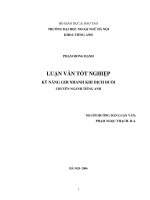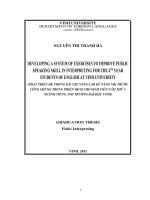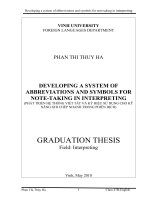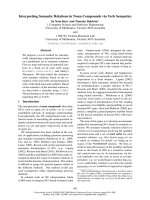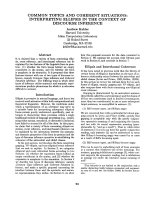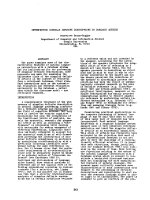Note-taking in Consecutive Interpreting
Bạn đang xem bản rút gọn của tài liệu. Xem và tải ngay bản đầy đủ của tài liệu tại đây (563.6 KB, 52 trang )
Note-taking in Consecutive Interpreting
INTRODUCTION
1. Rationale
Interpreting, like playing chess, is a game of problem solving,
evaluation, critical thinking, intuition and forecasting. Every game is different
and each game is a challenge, which requires interpreters, to unceasingly
develop knowledge and experience. It is disciplined study and repeated
practice of many techniques and
skills
that
bring victory to the interpreter.
Apart from basic requirements of language mastery and culture sensitivity,
there are quite a few skills that need to be acquired for successful interpreting.
One of them is note-taking skill.
Taking notes simply means quickly writing down information as a
record or reminder. However, note-taking might be compared with a move in
chess; to understand how to make the move is quite easy, but to master it in
order to create a winning combination of the move and the others is a hard and
demanding job.
Note-taking in consecutive interpreting is a skill to be learned. There is
no abstract theory about the skill, but there are a wide range of practical
principles laid down by succeeding generations of consecutive interpreters
over time. These principles have been made of both empirical studies digging
deep into nearly every aspect of the skill and research books elaborating
main theoretical approaches to it.
2. Aims and objectives of study
Nguyễn Anh Vũ _K13I
1
Note-taking in Consecutive Interpreting
By no means exhaustive, the ambition of this thesis is only to actively,
effectively and directly contribute to the further research, development and
implementation of note-taking in consecutive interpreting. The thesis can be
seen as an overall picture that helps student interpreters to have a general
view of fundamental things about the skill and also to explore “the shape”
of the note-
taking in other novices’ points of view.
This study is a methodical investigation into the subject of note-taking
in consecutive interpreting; a focused and systematic request for
information that may go beyond generally available knowledge to
acquire more in-depth analysis and elucidatory comment on the topic. It is a
product of a long searching process with a
series
of
activities unfolding over
time. It involves a number of things such as the collection of data, the evaluation
of results, and so on
3. Scope of study
The intended audience will be students of foreign language universities
and colleges who may wish to read a detailed depiction of some background
knowledge about note-taking skill and may be eager to understand the
viewpoints of other fellow students on the skill. Hence, first of all, this paper
will hopefully provide them with an overview of note- taking. Secondly, it
can also be of some use to those who wish to become interpreters in the
future.
4. Method of study
This paper is carried out by the following steps:
Nguyễn Anh Vũ _K13I
2
Note-taking in Consecutive Interpreting
- Have the instructions from my supervisor and friends
- Collecting materials from printed and electronic reference material
- Data analysis
5. Design of study
My graduation paper is divided into three main parts:
Part A: Introduction
This part has introduced the reasons, Aims, Scope, Method, and Design of
study.
Part B: Development
This part has three chapters:
Chapter 1: Literature review
Chapter 2: Methods, procedures and results
Chapter 3: Dicussion and Suggestions
Part C: Conclusion
Nguyễn Anh Vũ _K13I
3
Note-taking in Consecutive Interpreting
DEVELOPMENT
CHAPTER 1: LITERATURE REVIEW
1.1. Definitions of translation and interpretation
1.1.1. Definitions of translation
In order to give a clear definition of interpreting, it is useful to relate it to
another activity for which interpreting is often mistaken- translation. A
straightforward explanation of translation given by Catford (1965, p.11) can
help even non-professionals have an overall picture of what translation is. He
simply described translation as an “operation performed on languages, a
process of substituting a text in one language for a text in another”. Another
definition of translation put forward by Edmond Cary (1985, p. 85), as cited in
Lederer, 2003, on page 7, has received the approval from many linguistic
theorists.
Translation is a process which attempts to establish equivalents between
two texts expressed in two different languages. These equivalents are, by
definition, always dependent on the nature of the two texts, on their objectives,
on the relationship between the two cultures involved and their moral,
intellectual and emotional conditions.
Nguyễn Anh Vũ _K13I
4
Note-taking in Consecutive Interpreting
1.1.2. Definitions of interpreting
What is Interpreting? To arrive at a convincing answer to this question,
Roderick Jones, a
European Union senior conference interpreter, did not set up
a “standard” definition of
interpreting. He only stated that interpreting is
“immediate oral translation” (2002, p.3). Interpreting, just like translation, is
fundamentally the art of re-expressing. The interpreter listens to a speaker in
one language, gets the content of what is being said, and then immediately
verbally re-expresses his or her understanding of the meaning in another
language. From other angle, Cynthia Roy (2000, p.3) applied the linguistic
approaches of discourse analysis to
the
analytical
study of interpreting in her
book entitled Interpreting as a discourse process. She
said,
“Interpreting
for people who do not speak a common language is a linguistic and social
act of communication”. That means interpreting is a process of conversational
exchanges between two primary speakers and through a person called
interpreter who has knowledge and understanding of the entire
communicative situation, including fluency in languages, competence in
appropriate usage within each language, and in managing the cross-cultural
flow of talk.
It is obvious that both interpreting and translation “…consist of
understanding an original text, deverbalizing its linguistic form and then
expressing in another language [with] the ideas grasped and emotion
felt…”
(Marianne Lederer
, 2003, p.8), however, while translation refers to
converting a written text from one language into another, interpreting refers to
orally converting one spoken language into another.
1.1.3. Relation between translation and Interpreting
Nguyễn Anh Vũ _K13I
5
Note-taking in Consecutive Interpreting
Both interpreters and translators are required to have a good command
of the native language and at least a foreign language, analytical ability, high
concentration, subject matter knowledge and sensitivity to
cultural
issues.
However, there are different sets of indispensable skills for each. While a
translator must also be sharp writer and skilled editor, it is important for
an interpreter to have extraordinary listening abilities, exceptionally good
memory aided by good note-taking techniques and excellent public speaking
skills.
In
addition
,
interpreters must have intellectual capacity to
immediately
transform idioms, colloquialisms and other culturally specific
references into similar
statements that the target audience can understand
without the using dictionaries and supplemental reference materials. Above
all, unlike translators, interpreters have to deal with oral message under time
constraints without the opportunity of revising, improving or polishing their
interpretation. For these reasons, many people who see interpreters at work
think that being an interpreter is extremely demanding and challenging.
1.2. Consecutive Interpreting
1.2.1. Brief description of Consecutive Interpreting
As far as the classification of interpreting is concerned, most people who
get involved into linguistic study, would give their attention to what is
meant by consecutive interpreting and simultaneous interpreting. In fact,
consecutive and simultaneous are the two sub-types of interpreting, based on
the interpreting mode used by the interpreter: simultaneous, which occurs
nearly at the same time as the original utterance of a speech; consecutive,
which follows a chunk of speech varying in length from very few sentences to
Nguyễn Anh Vũ _K13I
6
Note-taking in Consecutive Interpreting
an entire speech lasting several minutes. A more detailed picture of differences
between the two main modes of interpreting can be seen clearly with the
definition given by Jones (2002, p.5- 6). He stated that a consecutive interpreter
“listens to the totality of a speaker’s comments, or at least a significant
passage, and then reconstitutes the speech with the help of notes taken while
listening; the interpreter is thus speaking consecutively to the original speaker,
hence the name”. And he explained the second mode as follows: “Here the
interpreter listens to the beginning of the speaker’s comments then begins
interpreting while the speech continues, carrying on throughout the speech, to
finish almost at the same time as the original. The interpreter is thus speaking
simultaneously to the original, hence again the name”.
From the above brief description, it is clear that the primary and
significant difference between consecutive interpreting and simultaneous
interpreting is the time gap between
the delivery of the speaker’s message and
the beginning of the interpretation. However,
whether working consecutively
or simultaneously, the interpreter first has to actively listen to the speaker,
properly understand and logically analyze what is being said and then
restructure the speech in an appropriate equivalent in a different language.
1.2.2. Two phases of Consecutive Interpreting
Wei HeZhong cited on page 1, in the article- Memory Training in
Interpreting that Daniel Gile (1992, 1995) views consecutive interpreting as a
process consisting of two separable phases. The first phase is listening during
which the interpreter listens to the source- language speech and takes notes;
the second phase is reformulating, during which the interpreter reproduce a
Nguyễn Anh Vũ _K13I
7
Note-taking in Consecutive Interpreting
target- language speech from memory and from notes.
Phase One- Listening Phase:
CI = L (listening) + M (short-term memory) + N (note-taking)
In this phase, the interpreter is required to listen attentively, selectively and
actively to the original speech, then the interpreter’s short-term memory is used to
store the messages that have been heard to put them either in
memory
or in notes or
both. It is easy to recognize that note-taking is an undivided part of the first phase.
Phase Two- Reformulation Phase:
CI = R (remember) + R (read the notes) + P (produce the speech in the target
language)
In the second phase, interpreter retrieves messages from their memory as
well as from the notes, and produces the speech in the target language.
Consecutive interpreters are said to produce a more accurate and equivalent
interpretation than simultaneous colleagues because “the interpreter does
not need to split their attention between receiving the message, and
monitoring their output, as is required in simultaneous, they can devote more
of their processing to analysis and reformulation of the text” (Santiago, 2004,
p.5). Moreover, because consecutive interpreters have time to
take notes which
serves as a very effective tool of the interpreters. As introduced in the
first
chapter, the main focus of the thesis is on the skill of note-taking in
consecutive interpreting.
1.3. Note-taking in Consecutive Interpreting
1.3.1. Fundamental principles of note-taking
During the interpretation process, both memory and notes should be
cultivated. While memory is of crucial to interpreters, notes can be of certain
Nguyễn Anh Vũ _K13I
8
Note-taking in Consecutive Interpreting
support.The importance of note-taking in consecutive interpreting had not
been well recognized until Rozan laid down fundamental principles of note-
taking in 1956 and Seleskovitch solidified the benefits of the skill in 1975.
Experience has shown that the consecutive interpretation of speeches that are
longer than two or three minutes requires at least some forms of note-taking,
of course, this also depends on the interpreter’s personal need, expertise and
familarity with the subject. Note taking has been proved to be very useful for
the interpreter working consecutively.
1.3.2. Effect of notes
Firstly, notes improve concentration; prevent distraction, thus
facilitating the reception and analysis of the speech. Secondly,
notes
help
the
interpreter relieve the memory. Although the interpreter may have understood
the ideas of a speech, he or she cannot remember every point in the speech
because one characteristic of short-term memory is that it only keeps
information for a limited amount of time, cognitive scientists also show that for
nearly all speakers of all languages, list retention peaks at around seven items,
plus or minus two. By recording the specific details and data such as proper
names, numbers, figures, lists of things, or specialized terms, technical
expressions,
etc,
notes
release the interpreter from bearing the whole thing in
mind. Thirdly, as mnemonic, notes activate the memory of the interpreter with
cues or signals that call up the information in the speech. With notes, the main
ideas, the secondary elements and the links among them become clear and
easier for the interpreter to visualize. Finally, notes can also be used to
highlight missing details, inconsistencies within the speech and anything
implausible that
needs attention latter. Conspicuously, the skill of note-taking
is very helpful to interpreters, the content and structure of a speech are
Nguyễn Anh Vũ _K13I
9
Note-taking in Consecutive Interpreting
reflected in notes, and the notes in turn are used as a path to verbalize the
speech.Thus, notes play an important part in consecutive interpreting.
However, taking proper notes needs a lot of practice, and the gap between the
“theory of note-taking” and “actual notes” can be very large. In order to
bridge
the
gap, first, an understanding of note-taking process is required.
1.4. Note-taking Process in Consecutive Interpreting
1.4.1. Need of understanding words
According to Jones (2002, p.39), note-taking is part of the whole
process of consecutive interpreting including: understanding, analysis and re-
expression, and if these activities “are not done correctly, the best notes in the
world will not make a good interpreter”. It can be seen from the diagram
below (figure 1) that if the
speech
has
not been fully understood, all efforts to
take notes are just in vain. In this case, the interpreter may only write down
individual words which are put together forming a meaningless chunk of
information. And if note-taking is separated from the activity of analyzing the
speech, the interpreter may be lost in the information overload.
1.4.2. Process of note-taking
The interpreter cannot identify what are the main ideas, what are the
secondary elements, and what are the connections between them in order to
decide what should be noted and what should not. Inevitably the notes become
nothing more than a mess, which will definitely push the interpreter in a very
difficult situation later. When looking back notes, the interpreter cannot have a
clear review of the speech content. And this obviously goes against one of the
basic functions of notes. The process of note-taking is not a simple one. In
order to make notes become an aid to enhance consecutive interpreting, the
interpreter must answer the three basic questions as follows: (i) what to note;
Nguyễn Anh Vũ _K13I
10
Note-taking in Consecutive Interpreting
(ii) how to note; and (iii) when to note.
Figure1.1. Connection between the process of consecutive interpreting
and note-taking
1.5. What to note
Notes taken by students have shown that they tend to stick to words.
They hesitate to free themselves
to
concentrate
on meaning by throwing away
the lexical form like words and structures etc. They try to retain each word of
the source utterance, consequently, their short- term memory will be quickly
overloaded with individual lexical items, which may
not even form a
meaningful sentence. Moreover, their attention will be wasted on finding
Nguyễn Anh Vũ _K13I
11
Note-taking in Consecutive Interpreting
equivalent lexical items in the target language rather than the meaning of
incoming message.
Clearly,
these
students may not have recognized that
things to be noted are logically related to “the mental analysis of the
speech”. Notes are not expected to be complete or organized exactly the same
way as in the
original
speech.
Instead they are expected to provide the cues
necessary to remember the information in the speech. Notes can be compared
to the skeleton outline of the speech shaped with main ideas and the links
between them.
1.5.1. Main Ideas
The first thing to be noted should be main ideas. For the fact that the
writing speed is always slower than speaking speed, it is impossible for the
interpreter to write down everything spoken by the speaker. The interpreter is
required to have the ability to identify, select and retain important ideas but
omit anything which is not relevant to the understanding of the original
speech. Furthermore, by recording the main ideas in notes, the interpreter
easily traces back the structure of the speech; hardly misses out important
ideas; and always keeps fidelity to the original content.
1.5.2. The Links
The second thing the interpreter should consider to take notes is the links
between ideas. The
connections
between
individual ideas determine the
overall meaning of the speech. Thus it is necessary for the interpreter to
realize and render the such links. The ways in which ideas may be linked
together are (i) the logical consequence which is expressed clearly with words
such as consequently, as a result, accordingly or therefore; (ii) the logical
cause which can be recognized with the words because, due to, as, or since;
and (iii) opposition which often goes with but, yet, however or nevertheless
Nguyễn Anh Vũ _K13I
12
Note-taking in Consecutive Interpreting
(Jones, 2002, p.28-29). Hardly does the interpreter get confused, if he
or
she
notes links systematically.
It is just liken to the act of marking road for each
turn. Thanks to logical connections, the
interpreter can follow every movement
and direction change made by the speaker without any difficulty.
1.5.3. Noncontextualized Information
Numbers, proper names, lists of things and terminologies are some in
the group of the elements that cannot be recalled on the basis of analytical and
logical thinking in a given context. If the interpreter wants to
remember
these
elements, he or she has no choice but keeps repeating them over and over
again. Clearly this is not
a
preferable
manner because if the interpreter’s mind
is too preoccupied with rehearsing such “noncontextualized information”, in
all likelihood, the interpreter will be distracted from listening
comprehension and target language production. In addition, unlike “main
ideas” which have strongly impressed themselves on the interpreter’s mind
in the form of either specific images or general concepts and tightly linked
with each other, most of these elements are not tagged with any kind of
mental images and they independently stand on their own. Therefore, it is no
exaggeration to say that numbers, proper names, lists of things and
terminologies most deserve to be the priority of the interpreter’s note-taking.
1.5.4. Verb Tenses
According to Jones, it is also important to note down tenses of verbs.
That means “when noting verbs, interpreters should thus take care to note
the tense correctly, and if appropriate the mode, in particular conditional”
(p.42). The modes and tenses of verbs have decisive influence on the meaning
of a sentence.
To sum up, in the notes of consecutive interpreter, at least main ideas
Nguyễn Anh Vũ _K13I
13
Note-taking in Consecutive Interpreting
and the links between them
must
appear
in order to help the interpreter
visualize the structure of the speech. Besides, to relieve the memory, the
interpreter should also note down “noncontextualized elements”
including numbers, proper
names,
lists
of things and
terminologies, etc.
Other things like tenses of verbs and points of view of the speaker may
be or
may not be noted down, depending on the decision made by each
individual interpreter under certain circumstances. Some interpreters prefer the
notes with very little detail while others prefer taking advantage of the notes
with as much detail as possible. Both attitudes are justifiable provided that
notes are not allowed to be counterproductive, harming the interpreter’s
listening comprehension and target language production.
1.6. How to Note
In order to take notes effectively, the most important thing the
interpreter must do is to decide what to note. However, according to
experienced interpreters, how to note is also very important. Conspicuously,
notes that are clearly separated and logically organized help the interpreter
avoid all confusion when reading back notes. And notes using
abbreviations and symbols are very helpful in activating the most information
with the least effort.
1.6.1. Abbreviations and Symbols
First and foremost, notes should be as economical as possible in
order to save the interpreter’s effort on writing. In this case, abbreviations
and symbols appear to be efficient tools. So far, several attempts
have
been
made to create complete system of abbreviations and symbols used in notes
for consecutive interpreting. The first of these is Becker system. Becker was a
conference interpreter and interpreter trainer and he created special cues for
Nguyễn Anh Vũ _K13I
14
Note-taking in Consecutive Interpreting
note-taking. His Notizenschift and Symbolschrift offers many tips for
inventing symbols and abbreviations. The other note-taking system was
created by Matyssek who deviced the similar system with sophisticated
rules so that complex symbols could be derived from basic one in his
Sprachunabhangige Notation. However both note-taking systems can never be
as effective as the one intended to supplement the memory of consecutive
interpreter for the reason that they are used to encode all
information in
systematic way for wider use not just for interpreters only (Láng, n.d).
The use
of symbols and abbreviations should be automatic because any new one
created in the process of interpreting may require so much attention. It is not
advisable for the interpreter to be distracted from his work by whatever
causes. Only by developing his own system of abbreviations and symbols
beforehand, can the interpreter make them come to his pen automatically.
1 6.1.1. Abbreviations
Abbreviations help the interpreter take notes quickly, saving time spent
on other activities in the process of interpreting. These abbreviations must be
unequivocal and unambiguous enough for the interpreter to understand
immediately when reading back notes because under time pressure the
interpreter has no chance to reconsider the meaning of abbreviations. An
abbreviation may be
meaningless
to
others, but must be meaningful to the
interpreter using it.
There are many principles and rules for the use of abbreviations.
However the most important one is that abbreviations must be consistent, if
an interpreter has chosen “pop” standing for “popular” then he should find
another abbreviation for “population”, for example, “popon”. The following
suggestions about creating abbreviations are based on the truth that the fewer
Nguyễn Anh Vũ _K13I
15
Note-taking in Consecutive Interpreting
strokes are written; the more time can be saved.
- Write what is heard: The interpreter can write a word by recording its sound
only.
For example: high- hi; know- no; free- fre; fee- fe; night- nite; etc.
- Drop medial vowels:
For example: build- bld; legal- lgl; bulletin- bltn; save- sv; budget- bjt;
etc.
- Write initial and final vowels:
For example: office- ofs; easy- ez; follow- flo; value- vlu; open- opn; etc.
The rules of abbreviations set up by Rozan are classified into three
categories: (i) abbreviation of words; (ii) abbreviation to indicate verb tenses
and (iii) abbreviating the register.
- According to the first rule, “unless a word is short (4-5 letters), the interpreter
should note it in an abbreviated form” and “write some of the first and last
letters rather than trying to write as many letters as possible from the start
onwards” (Rozan, n.d). For example, Prod. could be read as “production”,
“producer”, “product” or “productivity” while Pr
on
, Pr
er
, Pr
ct
, Pr
vity
are
unambiguous.
- The second rule reads that “to indicate tense we add
ll
for the future and
d
for the past”
(Rozan, n.d.)
- The third one is applied to abbreviate expressions which are too long, for
example, “In order to arrive at some conclusion” can be noted “to end”; or
“Taking into account the situation at the present time” can be noted “as sit
on
now”; “with the intention
of/
with the purpose of” can be noted “to”. The rule
here is “wherever possible we must abbreviate by using a word which conveys
Nguyễn Anh Vũ _K13I
16
Note-taking in Consecutive Interpreting
the same meaning but is much shorter” (Rozan, n.d.)
The presentation of the table below is not aimed at systematically
displaying an ambitious collection of abbreviations. In the table, there are only
some abbreviations which have
been amassed through both personal experience
and practical observation
Abbreviation of common international organization should be
remembered by the interpreter.
The
working
environment of the interpreter
is varied, and he or she mostly often finds himself or herself at conferences
on a wide range of topics with many representatives coming from different
international
and/
or local organizations, agencies and corporations, etc. It is
possible to say that the interpreter must have some background knowledge
about those groups. It is the duty of the interpreter to remember their names in
abbreviation
as
part of the required knowledge. The following table contains
some
common names in abbreviation. You can see list of Abbreviation in
Common Use at Table 1, Lists of Names of International Organizations and
Agencies in Abbreviation and lists of Names of Vietnamese Agencies in
Abbreviation ( Appendixes)
1.6.1.2. Symbols
Although the abbreviation is commonly used in notes, its most
prominent drawback is that it tends to entice the interpreter to stick to the word
level instead of meaning level. In other words, it easily leads the interpreter to
think in terms of words rather than ideas, which could harm the interpretation.
Therefore symbols are more preferable for their capacity of representing ideas
and eliminating source language interference. A "symbol" is anything, a mark,
sign or letter used to represent a thing or a concept. Symbols are quicker and
Nguyễn Anh Vũ _K13I
17
Note-taking in Consecutive Interpreting
easier to write than words. Similar to abbreviations, firstly symbols need to
be prepared in advance. Any symbol improvised in the middle of interpretation
could drive the interpreter into a difficult and intense situation. One basic rule
for the interpreter: only use the symbols which are already stuck in the
mind. Secondly, symbols must be consistent. That means symbols are
instantly associated for the interpreter himself with the meaning he gives
them. Attending to this point, the interpreter can avoid mistakenly
“deciphering” the meaning of the symbols he or she uses. Followings are some
symbol examples retrieved from electronic source at Interpreter Training
Resource.
problem politics
repression democracy
impact
work
country money
meeting
inflation
continue
deficit
surplus
Nguyễn Anh Vũ _K13I
18
Note-taking in Consecutive Interpreting
on the other hand
until
on behalf
of
from
that time on
as opposed to before
all any
similar/
equal end
Tables 4: Symbols
Some could say that symbols clearly help the interpreter take notes more
quickly and effectively, and then it is wise to use as many symbols as possible.
However, it would not seem rational to set up a rigidly unchanged rule for a
degree of symbolization, each interpreter through practice would find their own
balance. For some, symbolizing as much information as possible is good. For others,
it is not necessary to do so.
To sum up, abbreviations and symbols are, like other elements in notes, “a
Nguyễn Anh Vũ _K13I
19
Note-taking in Consecutive Interpreting
means to an end, not an end in themselves” (Jones, 2002, p. 39). What is the use of
abbreviations and symbols, if they do not help the interpreter to do his work
better? For the interpreter to fully get benefits from note-taking, a system of
abbreviations and symbols that is logical, connected and unequivocal should be
developed on his or her own.
1.6.2. Note Arrangement
1.6.2.1. Diagonal Layout
It would seem that whenever the question of how to take notes arises, a
technique named “diagonal presentation” would come up. Diagonal presentation
was introduced by Rozan in 1956. Also regarded as
vertical
arrangement,
diagonal has been widely used by professional interpreters. The creation of
diagonal layout
is
based
on the fact that subject, verb and object are the most
important elements of a sentence which
contain
nearly
all information or meaning
of the sentence, then they should be clearly represented in notes. Applying this
technique, the subject, verb and object are arranged diagonally, from left to right
and from top to bottom of a page. However it does not mean that the interpreter only
note the subject, verb and object elements. Based on
the
structure,
the interpreter
can add other details in the notes if he or she wants. Diagonal layout is highly
recommended because of its clear presentation of notes. Notes in diagonal
arrangement are concise and succinct; focusing on ideas rather than words, unlike
notes in horizontal form which often tempt the interpreter to write as many words as
possible. Diagonal layout is described by
Jones (2002, p. 44)
Let’s take an example: “Prime Minister Pham Van Khai’s 2005 visit to Washington
reflected the significant improvement in bilateral relations”
Based on the diagonal layout, this could be noted:
Nguyễn Anh Vũ _K13I
20
Note-taking in Consecutive Interpreting
05 PM PVK’s vizit WA
in VN-US
rels
The following example is one of them. “Over the course of 1954, prices
rose, although not to the same
extent
as
income, thus the population’s net income
increased” is noted as follows.
(1) 54,
prices
(2) but
—————
no = income
(3) so
————
Pop
on
Word
for word on the first line: Over the course of 1954, prices rose,
Word for word on the second line: although not to the same extent as,
Word for word on the third line: thus the population’s net income increased.
With diagonal presentation, notes are arranged vertically, running from the left to
the right of a paper in a slanting way, which come along with the natural
movement of human eyes from left to right and from top to bottom (Jones, 2002,
p. 45). Moreover, information is also organized logically and clearly in diagonal
form. The interpreter seems to be able to immediately see the connections
Nguyễn Anh Vũ _K13I
21
Note-taking in Consecutive Interpreting
between the ideas.
1.6.2.2. Left-hand Margin
The way in which ideas are connected to each other is as important as
the ideas themselves. In terms of meaning, idea is a single unit. It is only when
they are linked together that a complete message is formed. Thus the crucial role
of the links between ideas is never denied. As mentioned above, one of the most
major elements that must be reflected in notes is the link. In other words, the
interpreter when taking notes cannot afford to ignore “link words”, for instance:
therefore, consequently, nevertheless, as a result, on the other hand, however, but,
or, and, yet etc.
It is best to leave a left-hand margin of one or two centimetres for links to
make sure that they are not confused with the other parts in notes. Obviously left-
hand margin will make links stand out and easy to identify. That is the reason why
a left-hand margin is frequently found in the notes of professional consecutive
interpreters. Futhermore, a left-hand column is ideal for marking missing ideas or
denoting any change in the flow of speech. The following example extracted from
Conference Interpreting
Explained
written
by Jones (2002, p.47) shows how
successfully left-hand margin works.
“Hungary has complained that its steel exports to the European Union are not able to
develop because of excessively restrictive tariff quotas. But the Union representative
pointed out that quotas are still underused by Hungary by a large margin, so the tariff
quotas themselves didn’t appear to be creating the difficulties” could be noted:
Nguyễn Anh Vũ _K13I
22
HU steel
export
cannot
develop
to EU
because tariff
quotas
too restrictive
but EU: HU
Underused a
lot
quotas
so quotas
not problem
The example is purely given to show the function of left-hand margin; hence it
has not been abbreviated and symbolized. However, as a matter of fact, because of
frequent appearance of link words in notes, it is prudent to have a system of symbols
for them. The
following table shows some symbols for link words.
1.7. Which Language Used in Note
1.7.1. Source language and target language
The question of consecutive interpreters’ choice of language for their notes
is still open for debate. The source language means the language in which a speech
is made in the original, and from which an interpretation is to be made. The target
language is the language into which a speech spoken in another language is to be
interpreted
An ideal “language-independent system” for note-taking was proposed by
Matyssek. However, up to
now,
this
suggestion has not come into reality for the
reason that such “complicated system of ciphers” would definitely place a big
burden on the interpreter’s memory. Except for Matyssek, most writers about note-
taking in consecutive interpreting tend to adopt one of two contrasting positions:
some advocate the use of the target language, e.g. Herbert 1952; Rozan 1956;
Seleskovitch 1957; Déjean Le Féal 1981; Laplace 1990 while others like Ilg 1988;
Alexieva 1993; Gile 1995 argue that the source language may be a better choice (as
cited in
Dam,
n.d,
p.4). Those who recommend using the target language basically
have two reasons: first, the target language logically forces the interpreter to put
aside the surface form of the incoming speech, instead, to concentrate on
the meaning layer, that means the interpreter can avoid “intellectual
laziness”,
following the speaker and noting their words passively; second, taking notes in
the
target language is thought to effectively facilitate the re-expression phase. For
others who doubt the
benefits
of
using the target language for taking notes defend
their point of view that writing notes in the target language, the interpreter has
more activities to deal with during listening, understanding and analyzing phase.
Moreover, taking notes in the target language, the interpreter cannot have “a full set
of notes at then end
of
a
speech” as he takes notes in the source language (Jones,
2002, p.60).
1.7.2. The choice of Interpreter
However, some recent findings from a research paper conducted by Hellen V.
Dam (n.d) have showed that “the choice of language in note-taking is governed by
mainly the status of the language in the interpreters’ language combination, i.e. whether
it is an A-language or B-language (A-language is also called mother tongue and B-
language is the language of which the interpreter has perfect mastery), and much less
than by its status in the interpreting task, i.e. whether it functions as the source language
